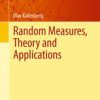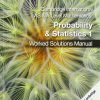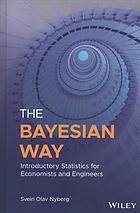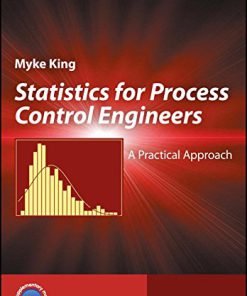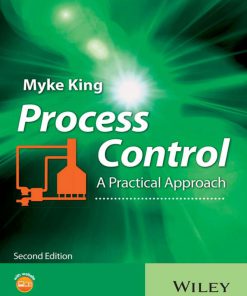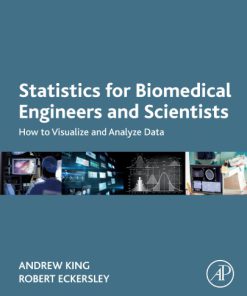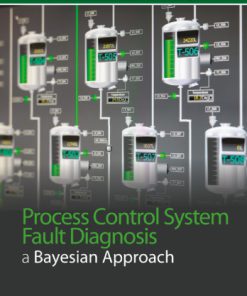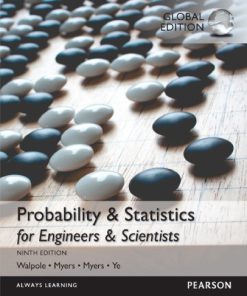Statistics for Process Control Engineers A Practical Approach 1st Edition by Myke King 1119383529 9781119383529
$50.00 Original price was: $50.00.$25.00Current price is: $25.00.
Statistics for Process Control Engineers A Practical Approach 1st Edition by Myke King – Ebook PDF Instant Download/DeliveryISBN: 1119383529, 9781119383529
Full download Statistics for Process Control Engineers A Practical Approach 1st Edition after payment.
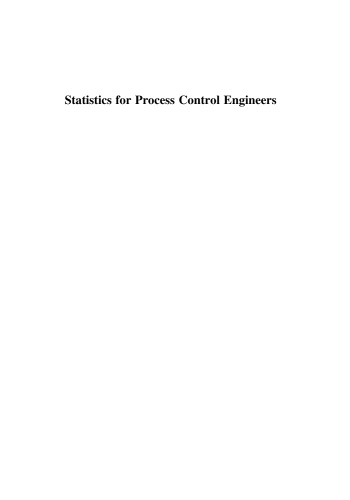
Product details:
ISBN-10 : 1119383529
ISBN-13 : 9781119383529
Author: Myke King
Statistics for Process Control Engineers is the only guide to statistics written by and for process control professionals. It takes a wholly practical approach to the subject. Statistics are applied throughout the life of a process control scheme – from assessing its economic benefit, designing inferential properties, identifying dynamic models, monitoring performance and diagnosing faults. This book addresses all of these areas and more.
The book begins with an overview of various statistical applications in the field of process control, followed by discussions of data characteristics, probability functions, data presentation, sample size, significance testing and commonly used mathematical functions. It then shows how to select and fit a distribution to data, before moving on to the application of regression analysis and data reconciliation. The book is extensively illustrated throughout with line drawings, tables and equations, and features numerous worked examples. In addition, two appendices include the data used in the examples and an exhaustive catalogue of statistical distributions. The data and a simple-to-use software tool are available for download. The reader can thus reproduce all of the examples and then extend the same statistical techniques to real problems.
Statistics for Process Control Engineers A Practical Approach 1st Table of contents:
Part 1: The Basics
1 Introduction
2 Application to Process Control
2.1 Benefit Estimation
2.2 Inferential Properties
2.3 Controller Performance Monitoring
2.4 Event Analysis
2.5 Time Series Analysis
3 Process Examples
3.1 Debutaniser
3.2 De‐ethaniser
3.3 LPG Splitter
3.4 Propane Cargoes
3.5 Diesel Quality
3.6 Fuel Gas Heating Value
3.7 Stock Level
3.8 Batch Blending
4 Characteristics of Data
4.1 Data Types
4.2 Memory
4.3 Use of Historical Data
4.4 Central Value
4.5 Dispersion
4.6 Mode
4.7 Standard Deviation
4.8 Skewness and Kurtosis
4.9 Correlation
4.10 Data Conditioning
5 Probability Density Function
5.1 Uniform Distribution
5.2 Triangular Distribution
5.3 Normal Distribution
5.4 Bivariate Normal Distribution
5.5 Central Limit Theorem
5.6 Generating a Normal Distribution
5.7 Quantile Function
5.8 Location and Scale
5.9 Mixture Distribution
5.10 Combined Distribution
5.11 Compound Distribution
5.12 Generalised Distribution
5.13 Inverse Distribution
5.14 Transformed Distribution
5.15 Truncated Distribution
5.16 Rectified Distribution
5.17 Noncentral Distribution
5.18 Odds
5.19 Entropy
6 Presenting the Data
6.1 Box and Whisker Diagram
6.2 Histogram
6.3 Kernel Density Estimation
6.4 Circular Plots
6.5 Parallel Coordinates
6.6 Pie Chart
6.7 Quantile Plot
7 Sample Size
7.1 Mean
7.2 Standard Deviation
7.3 Skewness and Kurtosis
7.4 Dichotomous Data
7.5 Bootstrapping
8 Significance Testing
8.1 Null Hypothesis
8.2 Confidence Interval
8.3 Six‐Sigma
8.4 Outliers
8.5 Repeatability
8.6 Reproducibility
8.7 Accuracy
8.8 Instrumentation Error
9 Fitting a Distribution
9.1 Accuracy of Mean and Standard Deviation
9.2 Fitting a CDF
9.3 Fitting a QF
9.4 Fitting a PDF
9.5 Fitting to a Histogram
9.6 Choice of Penalty Function
10 Distribution of Dependent Variables
10.1 Addition and Subtraction
10.2 Division and Multiplication
10.3 Reciprocal
10.4 Logarithmic and Exponential Functions
10.5 Root Mean Square
10.6 Trigonometric Functions
11 Commonly Used Functions
11.1 Euler’s Number
11.2 Euler–Mascheroni Constant
11.3 Logit Function
11.4 Logistic Function
11.5 Gamma Function
11.6 Beta Function
11.7 Pochhammer Symbol
11.8 Bessel Function
11.9 Marcum Q‐Function
11.10 Riemann Zeta Function
11.11 Harmonic Number
11.12 Stirling Approximation
11.13 Derivatives
12 Selected Distributions
12.1 Lognormal
12.2 Burr
12.3 Beta
12.4 Hosking
12.5 Student t
12.6 Fisher
12.7 Exponential
12.8 Weibull
12.9 Chi‐Squared
12.10 Gamma
12.11 Binomial
12.12 Poisson
13 Extreme Value Analysis
14 Hazard Function
15 CUSUM
16 Regression Analysis
16.1 F Test
16.2 Adjusted R
16.3 Akaike Information Criterion
16.4 Artificial Neural Networks
16.5 Performance Index
17 Autocorrelation
18 Data Reconciliation
19 Fourier Transform
Part 2: Catalogue of Distributions
20 Normal Distribution
20.1 Skew‐Normal
20.2 Gibrat
20.3 Power Lognormal
20.4 Logit‐Normal
20.5 Folded Normal
20.6 Lévy
20.7 Inverse Gaussian
20.8 Generalised Inverse Gaussian
20.9 Normal Inverse Gaussian
20.10 Reciprocal Inverse Gaussian
20.11 Q‐Gaussian
20.12 Generalised Normal
20.13 Exponentially Modified Gaussian
20.14 Moyal
21 Burr Distribution
21.1 Type I
21.2 Type II
21.3 Type III
21.4 Type IV
21.5 Type V
21.6 Type VI
21.7 Type VII
21.8 Type VIII
21.9 Type IX
21.10 Type X
21.11 Type XI
21.12 Type XII
21.13 Inverse
22 Logistic Distribution
22.1 Logistic
22.2 Half‐Logistic
22.3 Skew‐Logistic
22.4 Log‐Logistic
22.5 Paralogistic
22.6 Inverse Paralogistic
22.7 Generalised Logistic
22.8 Generalised Log‐Logistic
22.9 Exponentiated Kumaraswamy–Dagum
Chapter 23: Pareto Distribution
23.1 Pareto Type I
23.2 Bounded Pareto Type I
23.3 Pareto Type II
23.4 Lomax
23.5 Inverse Pareto
23.6 Pareto Type III
23.7 Pareto Type IV
23.8 Generalised Pareto
23.9 Pareto Principle
24 Stoppa Distribution
24.1 Type I
24.2 Type II
24.3 Type III
24.4 Type IV
24.5 Type V
25 Beta Distribution
25.1 Arcsine
25.2 Wigner Semicircle
25.3 Balding–Nichols
25.4 Generalised Beta
25.5 Beta Type II
25.6 Generalised Beta Prime
25.7 Beta Type IV
25.8 PERT
25.9 Beta Rectangular
25.10 Kumaraswamy
25.11 Noncentral Beta
26 Johnson Distribution
26.1 SN
26.2 SU
26.3 SL
26.4 SB
26.5 Summary
27 Pearson Distribution
27.1 Type I
27.2 Type II
27.3 Type III
27.4 Type IV
27.5 Type V
27.6 Type VI
27.7 Type VII
27.8 Type VIII
27.9 Type IX
27.10 Type X
27.11 Type XI
27.12 Type XII
28 Exponential Distribution
28.1 Generalised Exponential
28.2 Gompertz–Verhulst
28.3 Hyperexponential
28.4 Hypoexponential
28.5 Double Exponential
28.6 Inverse Exponential
28.7 Maxwell–Jüttner
28.8 Stretched Exponential
28.9 Exponential Logarithmic
28.10 Logistic Exponential
28.11 Q‐Exponential
28.12 Benktander
29 Weibull Distribution
29.1 Nukiyama–Tanasawa
29.2 Q‐Weibull
30 Chi Distribution
30.1 Half‐Normal
30.2 Rayleigh
30.3 Inverse Rayleigh
30.4 Maxwell
30.5 Inverse Chi
30.6 Inverse Chi‐Squared
30.7 Noncentral Chi‐Squared
31 Gamma Distribution
31.1 Inverse Gamma
31.2 Log‐Gamma
31.3 Generalised Gamma
31.4 Q‐Gamma
32 Symmetrical Distributions
32.1 Anglit
32.2 Bates
32.3 Irwin–Hall
32.4 Hyperbolic Secant
32.5 Arctangent
32.6 Kappa
32.7 Laplace
32.8 Raised Cosine
32.9 Cardioid
32.10 Slash
32.11 Tukey Lambda
32.12 Von Mises
33 Asymmetrical Distributions
33.1 Benini
33.2 Birnbaum–Saunders
33.3 Bradford
33.4 Champernowne
33.5 Davis
33.6 Fréchet
33.7 Gompertz
33.8 Shifted Gompertz
33.9 Gompertz–Makeham
33.10 Gamma‐Gompertz
33.11 Hyperbolic
33.12 Asymmetric Laplace
33.13 Log‐Laplace
33.14 Lindley
33.15 Lindley‐Geometric
33.16 Generalised Lindley
33.17 Mielke
33.18 Muth
33.19 Nakagami
33.20 Power
33.21 Two‐Sided Power
33.22 Exponential Power
33.23 Rician
33.24 Topp–Leone
33.25 Generalised Tukey Lambda
33.26 Wakeby
34 Amoroso Distribution
35 Binomial Distribution
35.1 Negative‐Binomial
35.2 Pόlya
35.3 Geometric
35.4 Beta‐Geometric
35.5 Yule–Simon
35.6 Beta‐Binomial
35.7 Beta‐Negative Binomial
35.8 Beta‐Pascal
35.9 Gamma‐Poisson
35.10 Conway–Maxwell–Poisson
35.11 Skellam
36 Other Discrete Distributions
36.1 Benford
36.2 Borel–Tanner
36.3 Consul
36.4 Delaporte
36.5 Flory–Schulz
36.6 Hypergeometric
36.7 Negative Hypergeometric
36.8 Logarithmic
36.9 Discrete Weibull
36.10 Zeta
36.11 Zipf
36.12 Parabolic Fractal
People also search for Statistics for Process Control Engineers A Practical Approach 1st:
what is statistical process control in manufacturing
statistical process control jobs
statistical process control for dummies
statistics for process control
statistical process control for manufacturing
Tags: Statistics, Process, Control Engineers, Practical Approach, Myke King
You may also like…
Mathematics - Mathematical Statistics
The Bayesian way: introductory statistics for economists and engineers First Edition Nyberg
Engineering
Process Control A Practical Approach 2nd Edition by Myke King ISBN 1119157749 978-1119157748
Business & Economics - Management & Leadership
Statistical Process Control: A Pragmatic Approach 1st Edition Stephen Mundwiller
Business & Economics - Management & Leadership
Statistical Process Control: A Pragmatic Approach 1st Edition Stephen 1351248499 9781351248495


